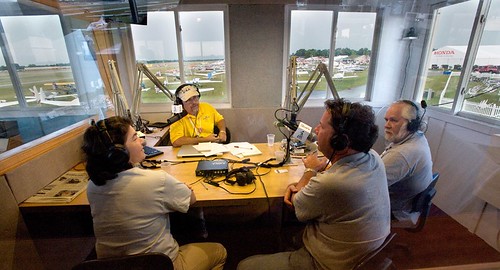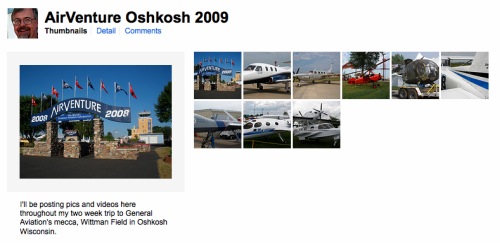The staff at the Jayhawk Wing Hangar consisted of just one before my arrival. At a table inside the hangar at Dead Cow International Airport Commemorative Air Force Col. Mike Flynn prepared the Wing's Fairchild PT-23 for an Independence Day appearance at Newton City County Airport.
Twenty-five miles away at EWK members of EAA Chapter 88 prepared for their annual Independence Day Fly-In; these great folks volunteered their Fourth of July to this event, some to prep pancake batter and all the trimmings and gather the ingredients for the charcoal-coooked burgers and hot dogs coming for lunch, while other went about the business of preparing the grounds and ramps for the impending arrival of dozens of planes, scores more fly-in visitors and hundreds of citizen visitors eager to spend a mild Saturday morning experiencing a typical mix of the humanity of aviation.
A few miles to the west on a private grass strip a group of vintage-aviation aficionados prepared to serve up a few hundred freshly flipped flapjacks to the flock of flyers already winging toward the smell of hotcakes and hot ham.
As Col. Mike completed his pre-flight work, another Dead Cow denizen arrived a bit belatedly, Ben. After enduring a bit of good-natured ribbing, Ben, Col. Mike and I joined to roll the PT -- "Miss Mickey" -- from her home and onto the ramp; Ben showed me how to help and together we next tackled rolling his recently restored Cessna 195 from her shelter.
Across the nation other aviators and their families took a tact a little different than those millions starting their day in anticipation of lake swims and campfire cook-out to come, while children of even advanced ages anxiously awaited the fireworks in the forecast.
Like thousands of others across the nation these two airplanes and three pilots joined in a celebration of our freedoms by exercising the flying privileges those freedoms allow.
First, the airplanes from Dead Cow dropped in on that early morning pancake breakfast hosted by the local Vintage Aircraft folks and the owner of the 2,450-foot private grass strip where we landed. When pilots utter the words, "Grass Roots Aviation," this strip and that morning gathering covered the image to a T.
That breakfast visit lead to an invitation to us in the C-195 to fly "top cover" for an Independence Day parade at a nearby small town. In the company of eight other aircraft -- two of them Stearman with smoke systems working -- flew two passes up the parade route.
None in these nine cockpits needed to hear any cheers; drawing cheers never occurred to anyone.
Pride in aviation, pride in America, pride in American Aviation, that was the gift, the ability to celebrate with such an act served as the reward. Besides, as anyone so blessed will testify, in the midst of performing a fly-by, the cockpits all stay busy keeping track of each other. No one on the ground wants to see a show that none of the pilots intended. So the pilots never actually see any sign of reaction down there.
From the parade route the C-195 turned northeast for a relaxed 2,500-foot cruise to Newton to partake of grass-roots flying of another form. The Chapter 88 gang worked full tilt checking in pilots and their planes, selling tickets for the evening banquet, and turning visiting children into documented Young Eagles courtesy the volunteer pilots and EAA.
The ramp held general aviation in its many forms, ultralights, trikes, homebuilts, spam cans, antiques and more than a few classics. The small improptu gathers of old friends and pilots and others who "get it" made a three-hour visit pass by at near Mach speed and soon the C-195 needed to wing its way home.
As the Businessliner touched down on the grass at Dead Cow and the crowds thinned at Newton, the PT-23 and Col. Mike cruised lazily home to the Jayhawk Wing Hangar to rest from a long day of enlightening many into the world of a World War II student pilot.
The Chapter 88 banquet most likely proved a fun evening for the participants and a well-earned reward to another successful Independence Day gathering.
Three landings and 50 miles of flying; operating at three airports, visiting two events, becoming a special event at a parade; spending time with dozens of friends and aviation lovers. What more could an aviator want out of a Fourth?
This day arose out of a decades-long tradition of flying on special days -- this day especially. But the more who do, the better.
No fireworks can match -- though we did envy the aviator flying a small GA airplane above Wichita last evening, when fireworks displays seemed to erupt above the black horizon at every point on the compass.
Hope your Fourth was as flyingly fulfilling.
Dave
 We had our second meetup last night at a local food&beverage place called Friar Tucks.
We had our second meetup last night at a local food&beverage place called Friar Tucks. UCAP Fodder
UCAP Fodder


